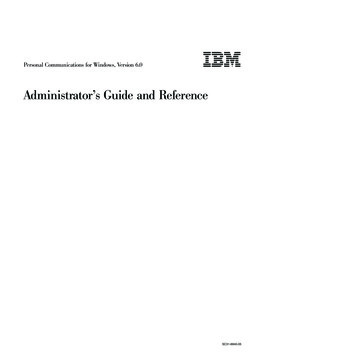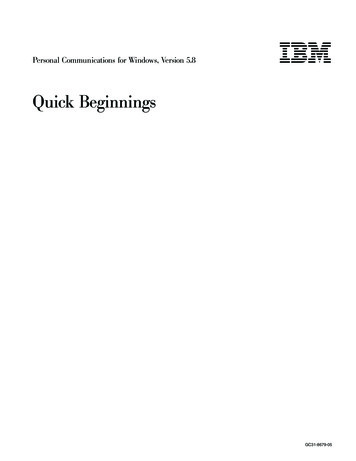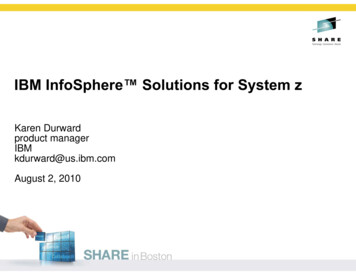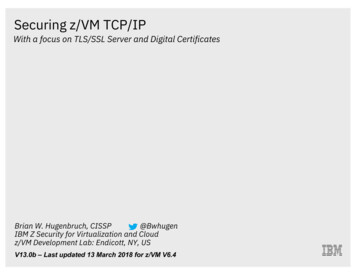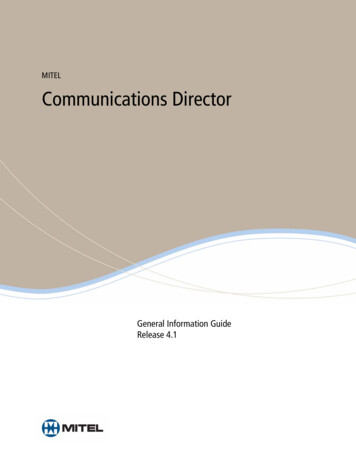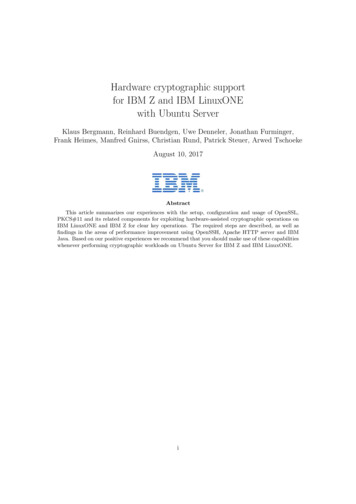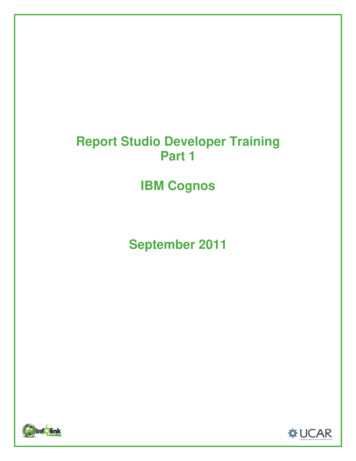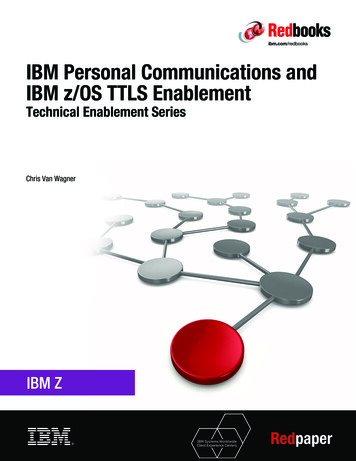
Transcription
Front coverIBM Personal Communications andIBM z/OS TTLS EnablementTechnical Enablement SeriesChris Van WagnerIBM Systems WorldwideClient Experience CentersRedpaper
IBM z/OS IBM Personal CommunicationsTTLS EnablementIn this IBM Redpaper publication, we describe the process of introducing Transport LayerSecurity to IBM z/OS so that IBM Personal Communications (PCOMM) uses TLS security.This document describes enabling Tunneled Transport Layer Security (TTLS) on your IBMz/OS for use with a PCOMM TN3270 connection. When you complete this task, you need acertificate to access your TN3270 PCOMM session.You work with the following products and components: TN3270TCP/IPPAGENTINET (maybe)IBM RACF We assume that the reader has extensive knowledge of z/OS security administration and ofthese products and components.This document is part of the Technical Enablement Series that was created at the IBM ClientExperience Centers.Warning: Enabling PCOMM TTLS introduces the possibility that you lose access to yourz/OS via PCOMM. Ensure that you have an alternative method to back out any changesthat are made. In this study, the following back-door process was to be used if disasteroccurs: Use an OSA-ICC connection to bypass TCP/IP/TN3270. For TN3270 changes, FTP configuration files that use native FTP were used. TCP/IPmust be working to do this. Access to shared DASD from another z/OS combined with HMC access to issueconsole commands. Copyright IBM Corp. 2019. All rights reserved.ibm.com/redbooks1
OverviewFigure 1 shows an overview of the steps that are described in this document.Figure 1 Steps to configurationFigure 2 shows the changes that are introduced to your environment.Figure 2 Updates to be madePrerequisitesFigure 3 You are here: PrerequisitesYou must have the following components successfully running: z/OS (this document was based on z/OS 2.3). UNIX System Services. This component of z/OS contains INET (you might have CINET). ICSF. You do not need a crypto card; instead, have ICSF running. TCP/IP is fully configured and successfully activated. TN3270 is fully configured and successfully serving a port to which you can connect withPCOMM.2IBM Personal Communications and IBM z/OS TTLS Enablement
You do not need to download any software or middleware. All of the instructions in thisdocument are configuration-related.Install and configure PAGENTFigure 4 You are here: Install and configure PAGENTPolicy AGENT (PAGENT) is a started task that points to files that contain policy statements.PAGENT interacts with TCP/IP and INET. PAGENT uses a keyring and must be configured forTLS to work properly (see Figure 5).Figure 5 Transition stageCreating the started taskThe z/OS RES should include the PAGENT procedure. Copy TCPIP.SEZAINST(PAGENT) to hlq .PROCLIB(PAGENT). The PAGENT PROC procedure is shown in Example 1.Example 1 PAGENT PROC//PAGENTPROC//PAGENTEXEC PGM PAGENT,REGION 0K,TIME NOLIMIT,// PARM 'ENVAR(" CEE ENVFILE DD:STDENV")/-c /etc/pagent.conf'//STDENVDD PATH '/etc/pagent.env',PATHOPTS (ORDONLY)//SYSPRINT DD SYSOUT *//SYSOUTDD SYSOUT *//CEEDUMP DD SYSOUT *,DCB (RECFM FB,LRECL 132,BLKSIZE 132)IBM z/OS IBM Personal Communications TTLS Enablement3
Creating the RACF STARTED profileAsk your RACF administrator to create the PAGENT.** STARTED profile. Figure 6 andFigure 7 show how the RACF STARTED profile should look.Figure 6 RACF Started profileFigure 7 RACF Started profileCreating /etc/pagent.confA sample of the /etc/pagent.conf (see Example 2) is included with z/OS and can be copiedby using the following commands:cp /usr/lpp/tcpip/samples/pagent.conf /etc/pagent.confchown 775 /etc/pagent.confExample 2 /etc/pagent.confTTLSConfig /etc/pagent TTLS.conf FLUSH fficOutgoingTOS11100000# Precedence bits (first 3 afficOutgoingTOS11000000}# encapsulated network affic# realtime data#IBM Personal Communications and IBM z/OS TTLS Enablement
TrafficOutgoingTOS00100000}Creating /etc/pagent.envExample 3 shows an example of /etc/pagent.env. The TZ variable defines the local timezone.Example 3 /etc/pagent.envPAGENT CONFIG FILE /etc/pagent.confPAGENT LOG FILE /tmp/pagent.logLIBPATH /usr/libTZ CST6CDT5Creating /etc/pagent TTLS.confz/OS provides a sample file for pagent TTLS.conf in/usr/lpp/tcpip/samples/pagent TTLS.conf.Copy this sample to /etc/pagent TTLS.conf by using the following commands:cp /usr/lpp/tcpip/samples/pagent TTLS.conf /etc/pagent TTLS.confchown 775 /etc/pagent TTLS.confNext, modify /etc/pagent TTLS.conf to add your key ring. There are two critical configurationitems in this file: the port 6001 and the ring TN3270 ring.IBM z/OS IBM Personal Communications TTLS Enablement5
Example 4 shows an example of /etc/pagent TTLS.conf.Example 4 /etc/pagent V3CipherSuitesV3CipherSuites6TN3270 10.0.0.0/00.0.0.0/060011024-65535Inbound255gAct1 TN3270eAct1 TN3270cAct1 TN3270gAct1 TN3270OneAct1 TN3270Server0TN3270 ringcAct1 TN3270Servercipher1 TN3270cAdv1 TN3270Off2cAdv1 TN3270OffOffOffOnOffOncipher1 TN3270TLS DHE RSA WITH AES 256 GCM SHA384TLS DH RSA WITH AES 256 GCM SHA384TLS RSA WITH AES 256 CBC SHA256TLS DHE RSA WITH AES 256 CBC SHATLS DHE DSS WITH AES 256 CBC SHATLS DH RSA WITH AES 256 CBC SHATLS DH DSS WITH AES 256 CBC SHATLS RSA WITH AES 256 CBC SHAIBM Personal Communications and IBM z/OS TTLS Enablement
itesTLS RSA WITH AES 128 GCM SHA256TLS DHE RSA WITH AES 128 GCM SHA256TLS DH RSA WITH AES 128 GCM SHA256TLS RSA WITH AES 128 CBC SHA256TLS DHE RSA WITH AES 128 CBC SHA256TLS DH RSA WITH AES 128 CBC SHA256TLS DHE RSA WITH AES 128 CBC SHATLS DHE DSS WITH AES 128 CBC SHATLS DH RSA WITH AES 128 CBC SHATLS DH DSS WITH AES 128 CBC SHATLS RSA WITH AES 128 CBC SHA}Granting access privilegesUse the following commands to grant access privileges to the files you created:chmod 775 /etc/pagent.envchmod 775 /etc/pagent.confchmod 775 /etc/pagent TTLS.confStarting the PAGENT procUse the following command to start the PAGENT PROC:/s pagentThe results should be similar to the results that are shown in Figure 8 on page 7.Figure 8 PAGENT startupThe task should remain up. Check SYSLOG for RACF errors (see Figure 9).Figure 9 SYSLOGTo see if the startup was successful, review the /tmp/pagent.log file. An example of asuccessful PAGENT startup is shown in Example 5.Example 5 Successful PAGENT startup04/24 12:20:07 LOG:000: .main: EZZ8431I PAGENT STARTINGIBM z/OS IBM Personal Communications TTLS Enablement7
12:20:07 INFO :000: .main: Compiled on Sep 26 2016 at 18:37:5912:20:07 INFO :000: .main: Use environment PAGENT CONFIG FILE '//'SYSL.ZLP7.TCPPARMS(PAGCNF)''12:20:07 INFO :000: .main: List all environment variables:12:20:07 INFO :000: .main: EXPORT ' CEE ENVFILE S DD:STDENV'12:20:07 INFO :000: .main: EXPORT 'PAGENT CONFIG FILE //'SYSL.ZLP7.TCPPARMS(PAGCNF)''12:20:07 INFO :000: .main: EXPORT 'PAGENT LOG FILE /tmp/pagent.log'12:20:07 INFO :000: .main: EXPORT ' BPXK SETIBMOPT TRANSPORT TCPIP'12:20:07 INFO :000: .main: using code page 'IBM-1047'12:20:07 INFO :000: .main: Using log level 312:20:07 LOG:000: main: EZZ8432I PAGENT INITIALIZATION COMPLETE04/2404/2404/2404/2404/24TCPIP12:20:07 LOG12:20:07 LOG12:20:07 LOG12:20:07 LOG12:20:07 LOG: TTLS04/24 12:20:07 LOGTCPIP:005: pzos install A ServiceClass: increase varsize for new gsk advanced:005: pzos install A ServiceClass: increase varsize for new gsk advanced:005: pzos install A ServiceClass: increase varsize for new gsk advanced:005: pzos install A ServiceClass: increase varsize for new gsk advanced:005: instantiate policies: EZZ8771I PAGENT CONFIG POLICY PROCESSINGparmsparmsparmsparmsCOMPLETE FOR:005: instantiate policies: EZD1586I PAGENT HAS INSTALLED ALL LOCAL POLICIES FORStopping and modifying the proc: To stop the proc, use the following command:/p pagentTo modify the proc, use the following command:/f pagent,refreshINET or CINET start up errorsYou might encounter errors when PAGENT is activated, as shown in the following example:EZZ4248E TCPIP WAITING FOR PAGENT TTLS POLICYIf you encounter this type of error, go to UNIX and the /etc/pagent.log and browse for errormessages. These messages often provide useful information.The following messages indicate a problem that is related to INET:SYSERR :001: plfm kernel init: socket(INET, DGRAM, 0) failed, errno EDC5112IResource temporarily unavailable., errno2 112B00B6OBJERR :001: init PEP and kernel: Kernel initialization failed for image 'TCPIP',OBJERR :001: check main config file: PEP/kernel initialization failed for image'TCPIP', config processing thread NOT createdINET is configured in hlq .PARMLIB(BPXPRMxx). The change to BPXPRMxx is shown inFigure 10 and an IPL often corrects the problem.8IBM Personal Communications and IBM z/OS TTLS Enablement
Figure 10 BPXPRM00 changes for INETVerifying successYou are looking for two things at this point: No glaring errors in the PAGENT started task output. No errors in /tmp/pagent.log.Figure 11 on page 9 shows an example of a successful PAGENT started task.Figure 11 Successful PAGENT started taskCheck /tmp/pagent.log for the following key messages:04/24 10:11:29 LOG:000: .main: EZZ8431I PAGENT STARTINGIBM z/OS IBM Personal Communications TTLS Enablement9
04/24 10:11:29 LOG:000: main: EZZ8432I PAGENT INITIALIZATION COMPLETE04/24 10:11:30 LOG:005: instantiate policies: EZZ8771I PAGENT CONFIG POLICYPROCESSING COMPLETE FOR TCPIP : QOS04/24 10:11:30 LOG:005: instantiate policies: EZZ8771I PAGENT CONFIG POLICYPROCESSING COMPLETE FOR TCPIP : TTLSRings, certificates, and certificate authoritiesFigure 12 You are here: Ring administrationThis section shows how to create a keyring, a certificate authority (CA) certificate that isconnected to the keyring, and a personal certificate that is signed with the CA certificate,which also is connected to the keyring.Creating a key ring, CA certificate, and a personal certificateThe job that is shown in Example 6 can be run to create the necessary key ring, a CAcertificate as default, and a personal certificate that is signed with a CA certificate.Warning: Use caution because this process deletes objects. Adjust the JCL as necessaryto fit your system’s configuration.Example 6 JCL to create a key ring, CA certificate and personal certificate//MAKECER2 JOB ,,MSGLEVEL 1,MSGCLASS H,CLASS A,REGION 0M/*JOBPARM SYSAFF **********************//* WARNING! This job deletes rings and certificates!!!*//* --------------- *//* Job instructions:*//*1. Enter valid jobcard above.*//*2. Change MY KEYRING to your key ring name. Ex: TN3270 ring *//*3. Change MY CA CERT to your CA cert name. Ex: ZLP6 CA cert *//*4. Change MY CERT to your non-CA cer. Ex: ZLP6 cert*//*5. Change HLQ to your personal HLQ on system.*//*6. Change NOTBEFORE to a not-before date YYYY-MM-DD.*//*7. Change NOTAFTER to a not-after date YYYY-MM-DD.*//*8. Submit. You should recieve RC 0 for every step.*//* --------------- *//* At the end of this job you should have the following:*//*Keyring: MY KEYRING *//*CA Cert: MY CA CERT (Connected to ring)*//*Non-CA Cert: MY CERT (Connected to ring)*10IBM Personal Communications and IBM z/OS TTLS Enablement
//*Data set: HLQ .CERTB64.CERT*//* --------------- *//* C. Van Wagner 2019-05-03 Initial //* Delete CA Cert if it *****************************//STEP010 EXEC PGM IKJEFT01,DYNAMNBR 30,REGION 4096K//SYSTSPRT DD SYSOUT *//SYSTSIN DD *RACDCERT CERTAUTH DELETE(LABEL(' MY CA CERT ')) ID(STCSYS)SETROPTS RACLIST(DIGTCERT DIGTRING) REFRESHSETROPTS RACLIST(FACILITY) ******************************//* Create CA ***************************//STEP020 EXEC PGM IKJEFT01,DYNAMNBR 30,REGION 4096K//SYSTSPRT DD SYSOUT *//SYSTSIN DD *RACDCERT CERTAUTH GENCERT SUBJECTSDN( o('IBM Corporation') ou('zBMC Certificate Authority') C('US')) NOTBEFORE(DATE( NOTBEFORE )) NOTAFTER(DATE( NOTAFTER )) KEYUSAGE(CERTSIGN) WITHLABEL(' MY CA CERT ')SETROPTS RACLIST(DIGTCERT DIGTRING) REFRESHSETROPTS RACLIST(FACILITY) ******************************//* Delete a non-CA ***************************//STEP030 EXEC PGM IKJEFT01,DYNAMNBR 30,REGION 4096K//SYSTSPRT DD SYSOUT *//SYSTSIN DD *RACDCERT ID(STCSYS) DELETE(LABEL(' MY CERT ')SETROPTS RACLIST(DIGTCERT DIGTRING) REFRESHSETROPTS RACLIST(FACILITY) ******************************//* Create a non-CA certificate and reference the CA cert ****************************//STEP040 EXEC PGM IKJEFT01,DYNAMNBR 30,REGION 4096K//SYSTSPRT DD SYSOUT *//SYSTSIN DD *RACDCERT GENCERT ID(STCSYS) SUBJECTSDN(CN('TN3270 Server') O('International Business Machines Corporation') C('US')) SIZE(2048) NOTBEFORE(DATE( NOTBEFORE ) TIME(11:00:00)) NOTAFTER(DATE( NOTAFTER ) TIME(11:00:00)) IBM z/OS IBM Personal Communications TTLS Enablement11
WITHLABEL(' MY CERT ') RSA KEYUSAGE(CERTSIGN DATAENCRYPT HANDSHAKE) SIGNWITH(CERTAUTH LABEL(' MY CA CERT '))SETROPTS RACLIST(DIGTCERT DIGTRING) REFRESHSETROPTS RACLIST(FACILITY) ******************************//* List the CA ***************************//STEP050 EXEC PGM IKJEFT01,DYNAMNBR 30,REGION 4096K//SYSTSPRT DD SYSOUT *//SYSTSIN DD *RACDCERT CERTAUTH LIST(LABEL(' MY CA CERT **************************//* List the non-CA ***************************//STEP060 EXEC PGM IKJEFT01,DYNAMNBR 30,REGION 4096K//SYSTSPRT DD SYSOUT *//SYSTSIN DD *RACDCERT LIST(LABEL(' MY CERT ')) ****//* At this point, you should have two certificates:*//*1. CA cert*//*2. Non-CA cert which references the CA cert.*//* Next, we will create a key ring and connect those ********************//* Delete key ring if it *****************************//STEP070 EXEC PGM IKJEFT01,DYNAMNBR 30,REGION 4096K//SYSTSPRT DD SYSOUT *//SYSTSIN DD *RACDCERT ID(STCSYS) DELRING( MY KEYRING ************************//* Create a key ***************************//STEP080 EXEC PGM IKJEFT01,DYNAMNBR 30,REGION 4096K//SYSTSPRT DD SYSOUT *//SYSTSIN DD *RACDCERT ID(STCSYS) ADDRING( MY KEYRING ************************//* List the key ***************************//STEP090 EXEC PGM IKJEFT01,DYNAMNBR 30,REGION 4096K//SYSTSPRT DD SYSOUT *//SYSTSIN DD *RACDCERT LISTRING( MY KEYRING ) ID(STCSYS)/*12IBM Personal Communications and IBM z/OS TTLS Enablement
*********************//* CONNECT THE non-CA Cert TO THE ***************************//STEP100 EXEC PGM IKJEFT01,DYNAMNBR 30,REGION 0M//SYSTSPRT DD SYSOUT *//SYSTSIN DD *RACDCERT ID(STCSYS) CONNECT(LABEL(' MY CERT ') RING( MY KEYRING ) *******************************//* CONNECT THE CA Cert to the ***************************//STEP110 EXEC PGM IKJEFT01,DYNAMNBR 30,REGION 0M//SYSTSPRT DD SYSOUT *//SYSTSIN DD *RACDCERT ID(STCSYS) CONNECT(CERTAUTH LABEL(' MY CA CERT ') RING( MY KEYRING ) USAGE(CERTAUTH))SETROPTS RACLIST(DIGTCERT DIGTRING) REFRESHSETROPTS RACLIST(FACILITY) ******************************//* Display the key ring which should now have 2 certs ********************************//STEP120 EXEC PGM IKJEFT01,DYNAMNBR 30,REGION 4096K//SYSTSPRT DD SYSOUT *//SYSTSIN DD *RACDCERT LISTRING( MY KEYRING ) ****//* At this point, you should have your key ring and certs connected. *//* If you don't something went wrong. Start over. Don't **********************//* Export a non-CA cert to a file so it can be sent to your PC/MAC. *//* After you make TCPIP / TN3270 changes, this is the magic key that *//* will permit you to authenticate with TN3270 (PCOMM).*//* Make sure you FTP this file to your PC in ASCII mode. You can*//* also just copy/paste it. It is ****************************//STEP130 EXEC PGM IKJEFT01,DYNAMNBR 50//SYSLBCDDDSN SYS1.BRODCAST,DISP SHR//SYSPRINT DDSYSOUT *//SYSTSPRT DDSYSOUT *//SYSTSIN DD*RACDCERT CERTAUTHEXPORT(LABEL(' MY CA CERT '))FORMAT(CERTB64) DSN(' HLQ .CACERT.EXPORT') PASSWORD('WELCOME')/*IBM z/OS IBM Personal Communications TTLS Enablement13
At the end of this job, you should have a key ring with the certificates as shown in Figure 13.Important: Be sure to review the results of the RACDCERT LISTRING command. Pay specialattention to ensure that the CA cert is DEFAULT. This part of the process is critical.Figure 13 Ring with connected certificatesExporting the CA certificateAs shown in Example 6, you created a user certificate that is signed with a CA certificate andexport the CA certificate to a flat file. Now, you must get that CA certificate to your PC whereyou can import it into a certificate management application. The certificate must be in thecorrect format. The exported file should look like the example that is shown in Figure 14.Figure 14 Exported CA certificateNow, you can FTP that file in ASCII mode to your PC. You can also paste it into a notepad.Figure 15 shows the FTP of the file to the PC in ASCII format (not BIN).14IBM Personal Communications and IBM z/OS TTLS Enablement
Figure 15 FTP the flat file to the PCThe file is saved with a .cer extension. Verify that the file arrived successfully to the PC.Importing the certificate to the PCThe next step is to import the certificate into your certificate database as a trusted certificate.Complete the following steps:1. Click Start IBM Personal Communication Certificate Management.This process starts a new window that is called IBM Key Management.2. Open the Key Database file by clicking Key Database File Open OK.3. Enter the password.4. Click the Add button (see Figure 16).Figure 16 IBM Key Management5. Find the .cer file that you transferred to your PC. Enter a name for the key whenprompted. This name can be anything you want. In our example, we used ZLP6 CA cert(see Figure 17). You receive a message that it was added successfully. Verify that thecertificate is in the list.IBM z/OS IBM Personal Communications TTLS Enablement15
Figure 17 The new certificate is added6. After you verify that the certificate is in the list, close the window. The configuration isautomatically saved.Tip: If you encounter any errors with the Certificate Management application, restart yourPC and attempt the import process again.CheckpointAt this time, you should have the following procedures and elements in place: 16PAGENT installed and running with no errorsTN3270 running with no changes madeTCP/IP running with no changes madeA new key ringA new personal certificate and CA certificate created and connected to your key ringThe new CA certificate on your PC and in your Certificate Management applicationIBM Personal Communications and IBM z/OS TTLS Enablement
Modify TCP/IPFigure 18 You are here: Modify TCP/IPWarning: Use caution when you changing the TCP/IP. You should have a back out plan incase you make a change that prevents you from accessing the configuration. It issuggested that you have a back door to the system so that you can undo any changes.In the test environment that is described in this document, we accessed the DASD fromanother z/OS and accessed the HMC. This combination permitted changes to be made tothe system and recycle TCP/IP, if needed.Identify your TCP/IP procedure and all associated configuration files. For this exercise, theexamples that are shown in Example 7, Example 8 on page 17, Example 9 on page 18,Example 10 on page 19, and Example 11 on page 19 contain the TCP/IP procedure and files.Example 7 hlq .PROCLIB(TCPIP)//TCPIPPROC PARMS 'CTRACE(CTIEZB00)'//TCPIPEXEC PGM EZBTCPIP,REGION 0M,TIME 1440,//PARM '&PARMS'//STEPLIB DD DSN SYS9.VTAMLIB,DISP SHR//SYSPRINT DD SYSOUT *,DCB (RECFM VB,LRECL 132,BLKSIZE 136)//ALGPRINT DD SYSOUT *,DCB (RECFM VB,LRECL 132,BLKSIZE 136)//CFGPRINT DD SYSOUT *,DCB (RECFM VB,LRECL 132,BLKSIZE 136)//SYSOUTDD SYSOUT *,DCB (RECFM VB,LRECL 132,BLKSIZE 136)//CEEDUMP DD SYSOUT *,DCB (RECFM VB,LRECL 132,BLKSIZE 136)//SYSERROR DD SYSOUT *//PROFILE DD DISP SHR,DSN SYSL.&PROJECT.PARMLIB(PELPROF)//SYSTCPD DD DISP SHR,DSN SYSL.&PROJECT.PARMLIB(PELDATA)//SYSFTPD DD DISP SHR,DSN SYSL.&PROJECT.PARMLIB(FTPDAT)Example 8 SYSL.&PROJECT.PARMLIB(PELPROF)INCLUDE SYSL.COMMON.DATA(PELBASE)INTERFACE &TCPLINKDEFINE IPAQENETIPADDR 129.40.&IPADDRS./&TCPMASKPORTNAME &TCPDEVCINBPERF DYNAMICVLANID &TCPVLANPRIROUTERHOME129.40.&IPADDRS &TCPLINKIBM z/OS IBM Personal Communications TTLS Enablement17
PRIMARYINTERFACE &TCPLINKBEGINROUTESRoute 129.40.&IPROUTE/&TCPMASK &TCPLINKRoute Default 129.40.&TCPGATE &TCPLINKENDROUTESITRACE OFFSTART &TCPLINKMTU 1500MTU 1500Example 9 SYSL.COMMON.DATA(PELBASE)SOMAXCONN 1024ARPAGE RTSTCPSENDBFRSIZE 65535TCPRCVBUFRSIZE 65535DELAYACKSUNRESTRICTLOWPORTSUDPCONFIGAUTOLOG 5FTP JOBNAME FTP1; FTPENDAUTOLOGPORT7 UDP MISCSERV7 TCP MISCSERV9 UDP MISCSERV9 TCP MISCSERV19 UDP MISCSERV19 TCP MISCSERV20 TCP OMVSNOAUTOLOG21 TCP OMVS25 TCP SMTP53 TCP NAMESRV53 UDP NAMESRV80 TCP OMVS111 TCP PORTMAP111 UDP PORTMAP135 UDP LLBD161 UDP OSNMPD162 UDP SNMPQE397 TCP VTAM44443 TCP OMVS446 TCP * DELAYACKS447 TCP * DELAYACKS448 TCP * DELAYACKS512 TCP OMVS513 TCP OMVS514 TCP OMVS515 TCP LPSERVE520 UDP OROUTED580 UDP NCPROUT623 TCP OMVS750 TCP MVSKERB750 UDP MVSKERB751 TCP ADM@SRV751 UDP ADM@SRV18; 256-256K (default 16K); 256-256K (default 16K)Server; Miscellaneous Server;;;;;;;;;;;;;;;;;;;;;;;;;;;FTP ServerFTP ServerSMTP ServerDomain Name ServerDomain Name ServerWebServerPortmap ServerPortmap ServerNCS Location BrokerSNMP AgentSNMP Query EngineVTAM AnyNet Support (TCP/IP over SNA)WebServer SSL supportDRDA DB2 SQL portDRDA DB2 SQL portDRDA DB2 Security SQL portRemote Execution ServerRloginRshellLPD ServerRouteD ServerNCPROUTE ServerOtelnet Server (OMVS stack)KerberosKerberosKerberos Admin ServerKerberos Admin ServerIBM Personal Communications and IBM z/OS TTLS Enablement
EMON01;;;;;;;;;;;;;Component BrokerCICS SocketCICS ListenerResync port for DB2Resync port for DB2Resync port for DB2Resync port for DB2Resync port for DB2Resync port for DB2Resync port for DB2Resync port for DB2Resync port for DB2Component F)(DDF)(DDF)(DDF)(DDF)(DDF)(DDF)(DDF)Example 10 SYSL.&PROJECT.PARMLIB(PELDATA)TCPIPJOBNAME TCPIP&TCPLINK.: HOSTNAME &TCPLINKDOMAINORIGIN PBM.IHOST.COMNSINTERADDR 129.40.106.1NSPORTADDR 53RESOLVEVIA UDPRESOLVERTIMEOUT 30RESOLVERUDPRETRIES 1DATASETPREFIX TCPIPLOADDBCSTABLES JIS78KJ JIS83KJ SJISKANJI EUCKANJI HANGEUL KSC5601Example 11 JESLRECL80JESRECFMFJESPUTGETTO600JESINTERFACEL LGDIRECTORYMODE FALSEINACTIVE300STARTDIRECTORY HFSWRAPRECORDFALSE;;;;;;;;;;;;;;;;;;;New data set allocation space typeNew data set allocation primary spaceNew data set allocation secondary spaceNew data set allocation directory blocksNew data set allocation record formatNew data set allocation logical record lengthNew data set allocation blocksizeLRECL of JES jobsRECFM of JES jobsTimeout for remote job submission put/getAllows to switch JESOWNERFile transfer mode (JES/SEQ/SQL)Automatic mount of unmounted volumeAutomatic recall of migrated data setsData sets cataloged if transfer failsDirectorymode vs. data set modeInactive time outUse HFS directory at connect timeData is NOT wrapped to next recordIBM z/OS IBM Personal Communications TTLS Enablement19
Modifying TCP/IPMake the following updates to the TCP/IP configuration in PARMLIB: Add TTLS to the TCPCONFIG section. Add PAGENT to the AUTOLOG section.In the example that is shown in Figure 19, the changes were made to the PELBASE memberin PARMLIB.Figure 19 Update the TCP/IP configuration in PARMLIBRunning the RACF commandsComplete the following steps:1. Create CLASS(SERVAUTH) EZB.INITSTACK. sysname .TCPIP with STCGRP(UPDATE).2. Permit user STCSYS to CLASS(OPERCMDS) profile IBM MVS .** access(UPDATE).STCSYS is the user ID that runs the TCP/IP procedure. You can validate this process, asshown in Figure 20 on page 20.Figure 20 Validate the user ID for TCP/IP20IBM Personal Communications and IBM z/OS TTLS Enablement
Figure 21 shows the resulting SERVAUTH class.Figure 21 The new SERVAUTH classRecycle PAGENT, TCP/IP, and TN3270 by using the following commands: /p tn3270 /p tcpip /p pagentWait until everything is successfully down. Then, issue the following commands: /s pagent /s tcpip /s tn3270IBM z/OS IBM Personal Communications TTLS Enablement21
Figure 22 shows the results of the commands that are used to stop TN3270 and TCP/IP.Figure 22 Stopping TN3270 and TCP/IPFigure 23 shows that the TCP/IP and TN3270 were removed.Figure 23 Termination completeAfter the tasks are restarted, you see them again in the Activity list, as shown in Figure 24.Figure 24 TN3270 and TCP/IP have been restartedVerificationLog in to PCOMM by using TN3270. If you cannot log in, stop. You did something wrong andyou must start over.Examine the TCP/IP started task output and look for messages about PAGENT. You shouldsee the messages that are shown in Example 12.Example 12 TCP/IP started task outputIEF695I START TCPIPWITH JOBNAME TCPIPIS ASSIGNED TO USER STCSYS , GROUP STCGRP HASP373 TCPIPSTARTEDIEE252I MEMBER CTIEZB00 FOUND IN SYSL.ZLP7.PARMLIB22IBM Personal Communications and IBM z/OS TTLS Enablement
IEE252I MEMBER CTIIDS00 FOUND IN SYSL.ZLP7.PARMLIBIEE538I CTINTA00 MEMBER NOT FOUND IN PARMLIBEZZ4210I CTRACE DEFINE FAILED FOR CTINTA00 RETURN CODE: 0000000C REASON CODE: 00000401 COMPONEEZZ0162I HOST NAME FOR TCPIP IS EX238N01EZZ0300I OPENED INCLUDE FILE 'SYSL.COMMON.DATA(PELBASE)'EZZ0300I OPENED PROFILE FILE DD:PROFILEEZZ0309I PROFILE PROCESSING BEGINNING FOR DD:PROFILEEZZ0309I PROFILE PROCESSING BEGINNING FOR SYSL.COMMON.DATA(PELBASE)EZZ0655I PORT 5555 TCP DAEMON01 IS ALREADY RESERVEDEZZ0316I PROFILE PROCESSING COMPLETE FOR FILE 'SYSL.COMMON.DATA(PELBASE)'EZZ0304I RESUMING PROCESSING OF FILE DD:PROFILEEZZ0328I LINK NAME EX238N01 ON LINE 35 HAS NOT BEEN DEFINED OR HAS BEEN DELETEDEZZ0316I PROFILE PROCESSING COMPLETE FOR FILE DD:PROFILEEZZ0303I INITIAL PROFILE FILE CONTAINS ERRORSEZZ0623I PATH MTU DISCOVERY SUPPORT IS ENABLEDEZZ0338I TCP PORTS 1 THRU 1023 ARE NOT RESERVEDEZZ0338I UDP PORTS 1 THRU 1023 ARE NOT RESERVED*EZZ4248E TCPIP WAITING FOR PAGENT TTLS POLICYEZZ4202I Z/OS UNIX - TCP/IP CONNECTION ESTABLISHED FOR TCPIPEZZ4340I INITIALIZATION COMPLETE FOR INTERFACE EX238N01EZB6473I TCP/IP STACK FUNCTIONS INITIALIZATION COMPLETE.EZAIN11I ALL TCPIP SERVICES FOR PROC TCPIP ARE AVAILABLE.EZD1289I TCPIP ICSF SERVICES ARE CURRENTLY AVAILABLE FOR AT-TLS GROUP grp DiagnosticEZZ4250I AT-TLS SERVICES ARE AVAILABLE FOR TCPIPEZD1176I TCPIP HAS SUCCESSFULLY JOINED THE TCP/IP SYSPLEX GROUP EZBTCPCSEZD1289I TCPIP ICSF SERVICES ARE CURRENTLY AVAILABLE FOR AT-TLS GROUP gAct1 T
2 IBM Personal Communications and IBM z/OS TTLS Enablement Overview Figure 1 shows an overview of the steps that are described in this document. Figure 1 Steps to configuration Figure 2 s
